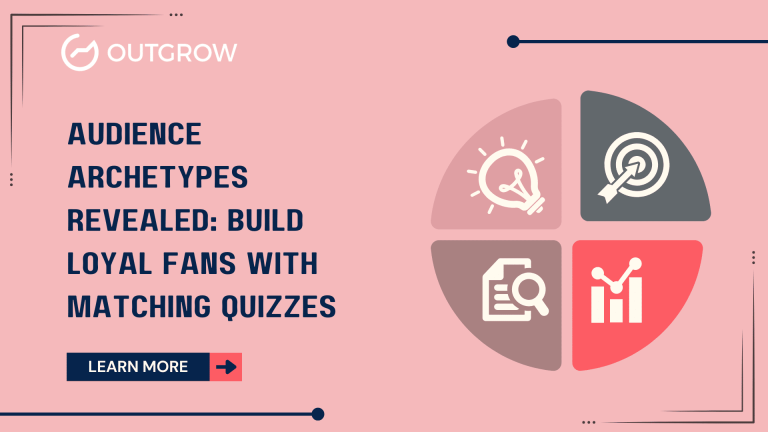Customer Centric Marketing: Strategies for Success and Growth
Table of Contents
Want to have more customers by spending less money? Well, we aren’t kidding! There are a few underused marketing strategies that brands have used to achieve this. And customer centric marketing is one simple way to get started. Let us show you how.
Customer-centric marketing is one of the most important strategies one can implement for their business. And hence, it’s worth understanding what it is and how it can benefit you. This blog post dissects the concept of customer centricity, shows how brands are using it, and explains ways you can use this strategy to improve your marketing.
What Is Customer Centric Marketing?
Customer centric marketing is how you do your marketing as a business to ensure that you are relevant, valuable, and memorable to your customers. So this means shifting the focus of your business from just understanding how to sell your products, well to, understanding how your customer can benefit from it.
The goal of customer-centric marketing is to enable customers to travel through the buyer’s journey on their terms and cater to the “whole” of the customer. This entails knowing your customers and understanding their needs, preferences, and pain points.
Let’s show you how some well-known brands that have successfully implemented customer-centric marketing strategies.
Customer Centric Marketing Examples
1. Airbnb
Airbnb has taken over the hospitality industry with its customer-centric approach. They provide unique, personalized accommodations and foster a sense of community through user reviews and host interactions. They have successfully captured the desire for authentic and personalized travel experiences.
2. Glossier
Glossier is a skincare and beauty brand that has gained a dedicated following by prioritizing customer feedback and engagement. They actively involve their customers in product development and marketing decisions which in turn creates a sense of community and loyalty.
3. Chubbies
Chubbies is a men’s clothing brand known for its customer-centric approach and engaging marketing campaigns. They prioritize understanding their target audience and creating a sense of community through social media and events, gathering a loyal customer base.
These brands have leveraged customer-centric marketing strategies to differentiate themselves in their respective industries and build strong relationships with their customers.
Why Do We Need Customer Centric Marketing?
Did You Know: According to a study by Deloitte, customer-centric companies are 60% more profitable compared to companies that are not focused on the customer.
Customer Centric Marketing is important for several reasons:
Build Stronger Relationships
By focusing on the needs and preferences of your customers, you can build stronger relationships with them. This can result in referrals and customer loyalty.
According to a study by Nielsen, 92% of consumers trust recommendations from friends and family over all other forms of advertising.
This indicates that building strong relationships with customers and generating positive word-of-mouth referrals can significantly impact a brand’s reputation and success.
These measures would cultivate loyal customers who are more likely to recommend the brand to their network, leading to increased customer acquisition and growth.
Increase Revenue
A customer-centric approach can lead to increased revenue. You can tailor your products and services to meet those needs. This leads to increased sales and customer satisfaction index in the long run.
Improve Customer Retention
Customer-centric approach results in improved customer retention. Happy customers are more likely to stay with your business and continue to make purchases.
According to research by Frederick F. Reichheld of Bain & Company, increasing customer retention rates by just 5% can lead to a profit increase of 25% to 95%.
This statistic underscores the significance of customer retention and the financial impact it can have on a business.
By prioritizing a customer-centric approach, businesses can enhance customer satisfaction, loyalty, and overall retention rates, which can ultimately contribute to improved profitability and long-term success.
Gain a Competitive Advantage
A customer-centric approach can help you stand out from your competitors. By understanding your customers better than your competitors, you can create more relevant marketing messages.
Listening to their pain points and feedback can also help you advance your products, and services before your competitors.
Reduce Costs
By following the fundamental steps of a customer-centric approach, you can reduce marketing costs. When you know what your audience wants, you can devote resources to selective strategies instead of doing hit-and-trial with ineffective campaigns.
3 Ways to Get Started With Customer Centric Marketing
Get To Know Your Customers A Little Better
Conduct market research and gather data to gain insights into your customers’ needs, preferences, and behavior. Use customer feedback surveys, and social media monitoring, to gather information about your target audience.
TIP: Conduct surveys to get insights into customer behavior, needs, and challenges. Ask specific questions in the survey about their requirements, their experiences with your or competitors’ services, and areas to improve your solutions.
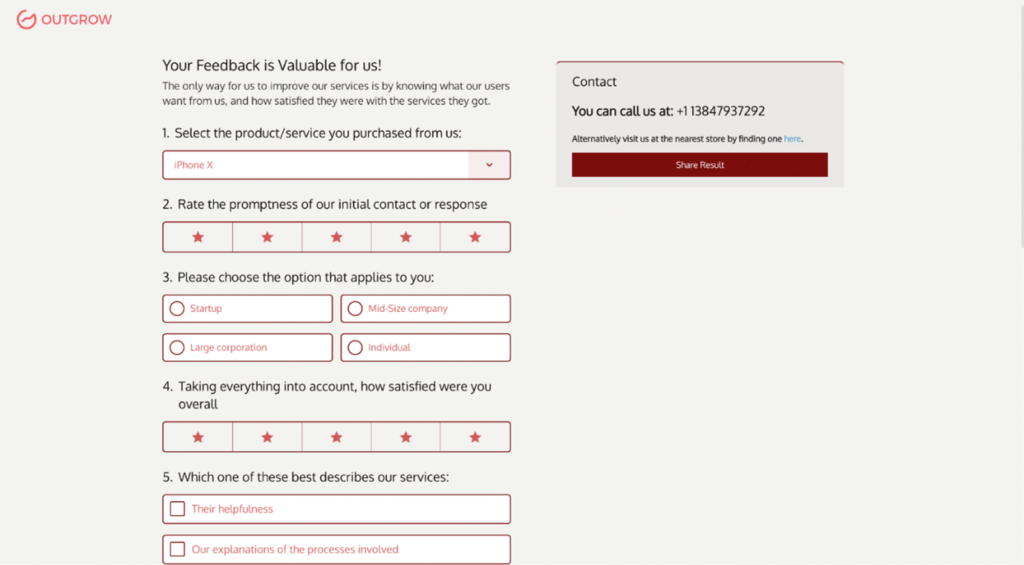
Create a Customer-Centric Website
A customer-centric website is one designed and optimized to provide a seamless and personalized user experience that caters to visitors’ needs and preferences.
This can be achieved by making your website interactive instead of delivering one-way messaging. But how to do that? Creating interactive content for your website is not at all tough. For example, you can add a quiz to your homepage for your visitors.
Step 1: Make a quiz using a no-code quiz maker.
Step 2: Embed it on your website.
There are different types of interactive content you can play with like calculators, quizzes, surveys, product recommendations, etc. based on your requirements.
Tip – You can use a tool like Outgrow and create all kinds of interactive content in one place. It has a variety of tools to boost your marketing strategies and make your brand stand out.
You can check out Outgrow’s premade templates, customize them, and make your own within minutes!

Leverage User-Generated Content
This refers to the practice of utilizing content created by customers or users of a product or service to enhance marketing and promotional efforts. This can include customer reviews, testimonials, social media posts, photos, videos, and other forms of user-generated content.
By incorporating user-generated content into marketing strategies, businesses can amplify social proof, build credibility, and engage their audience by showcasing authentic experiences and opinions of their customers. Collaborating with marketing agencies in Dubai can further enhance these efforts, bringing professional expertise to refine and maximize the impact of user-generated content.
Customer-Centric vs Product-Centric
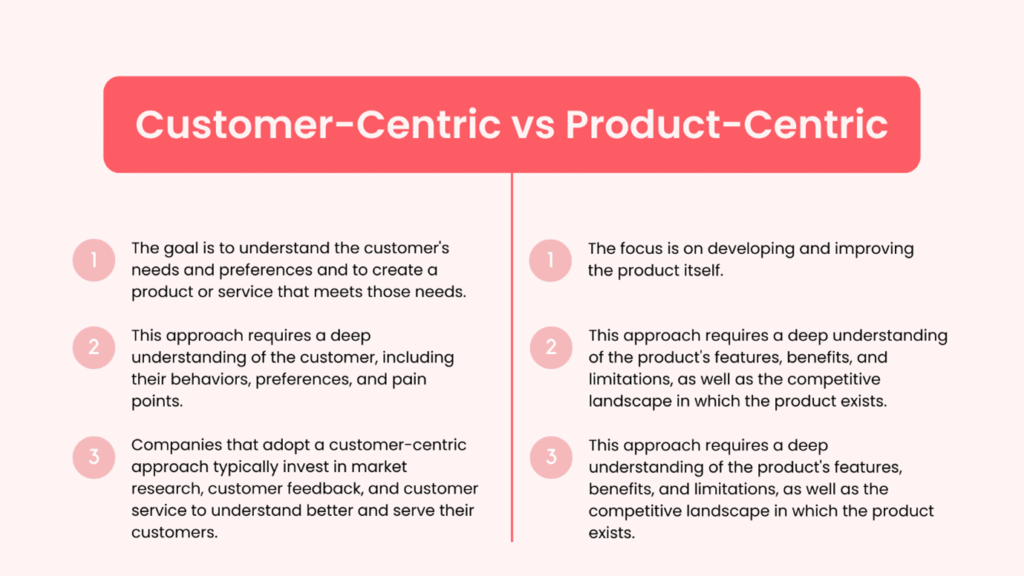
5 Ways to Succeed With Customer-Centric Marketing
1. Create personalized experiences to wow your customers
Use customer data to personalize your interactions with customers. If your customer data is stored in Amazon RDS, consider integrating it with BigQuery. By transferring data from Amazon RDS to BigQuery, you can access powerful insights to recommend products based on past purchases and tailor your communication to individual preferences. Address them by name, recommend products and services based on their past purchases, and tailor your communication to their preferences.
Let’s say you have an online retail store that sells custom clothing and accessories. You have a customer named Sarah who has made multiple purchases in the past, including linen dresses, handbags, and shoes. You can gather and analyze this customer data to personalize your future interactions with Sarah.
1. Personalize emails and chatbot and text messages
2. Recommend products through quizzes or based on past purchases
3. Tailor offers to their preferences
By personalizing your interactions with Sarah, you provide a more tailored and relevant experience. This increases the chances of engaging Sarah, enhancing her satisfaction, and potentially leading to future purchases.
READ MORE: Want to learn how to do personalized marketing for your customers? Check out our detailed blog on it!
2. Use customer feedback to shape new offerings
As we discussed earlier in the blog, another great way to customer centricity is creating surveys that talk directly to customers. A survey that is designed to capture users’ interests and pain points can work wonders for your marketing strategy.
However, creating a survey is not enough. You should ensure that the data which is being collected from the customers is being analyzed and their feedback is valued and implemented.
Sounds like too much work? Well, you won’t have to analyze all the data manually if you use a smart survey tool. A survey maker like Outgrow comes with powerful analytics, automation, and integration features to do the hard and smart work for you.
In fact, it also comes with multiple premade templates that you can customize with a few clicks. The bonus point is that you can try out the all-rounder Outgrow survey maker or form builder for free!
Once you’ve published a survey with Outgrow, its detailed performance could be measured under the Analyze tab. You can view total visitors, traffic, and other user details under this section. Additionally, for capturing feedback in physical locations, consider implementing a Windows Kiosk for feedback, to seamlessly gather insights from customers on-site.
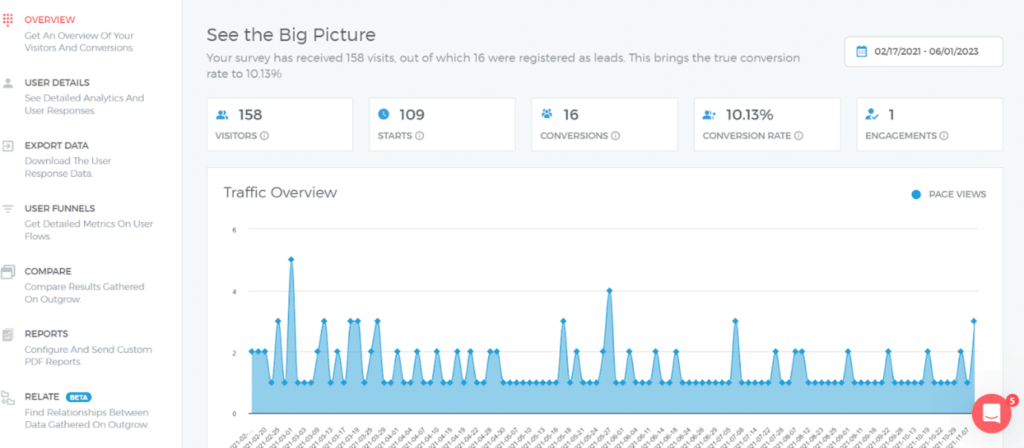
Want a step-by-step guide? Check it out here: How to Create a Survey in 5 Minutes
3. Ensure Easy Customer Support
In today’s digital age, providing easy and accessible customer support is crucial for businesses. Customers expect quick and convenient ways to get their questions answered and issues resolved. One effective way to achieve this is by leveraging chatbots.
They can be integrated into websites, messaging apps, or social media platforms, allowing customers to engage in real-time conversations and receive instant assistance. These interactions can contribute positively to the customer health score by enhancing overall satisfaction and support experience.
By implementing chatbots for customer support, businesses can offer several benefits:
- 24/7 Availability
- Instant Responses
- Consistency and Accuracy
- Scalability
- Cost Savings
If you want to try out chatbots that can be easily integrated into multiple platforms, take a look at the Outgrow chatbot that now comes with the power of AI.
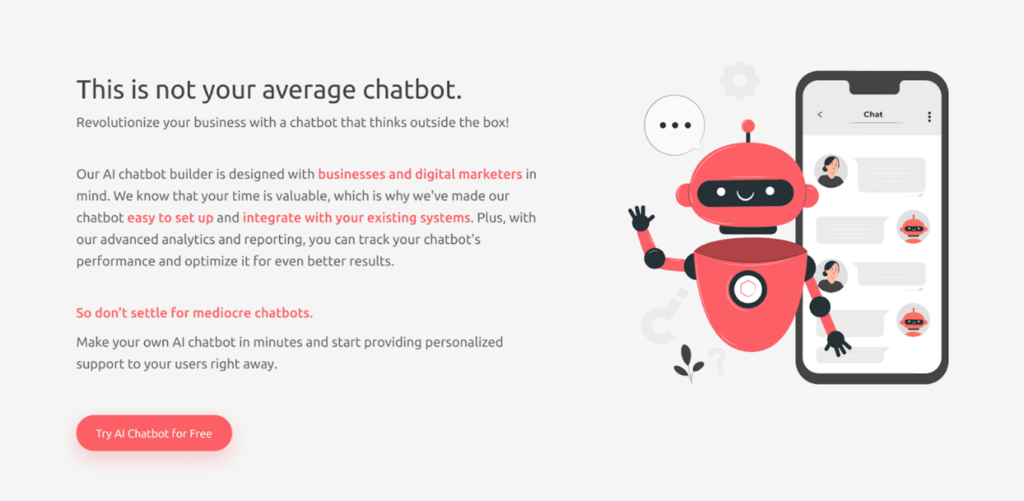
Check It Out Here – How to Build Chatbots Using No-Code Chatbot Builder
4. Keep an eye on trends, but don’t just follow the crowd
To stay one step ahead of the competition, you need to be able to identify new trends in your industry and then act on them before anyone else does. If you want to stand out, position yourself as an expert who can provide valuable information on upcoming technologies or strategies.
Ask yourself questions like “What is the latest trend in my industry that could potentially be profitable for my customers?”
One such example is Mint.
Establishing a presence in a highly competitive niche like personal finance (or any popular niche) can be intimidating for a new startup.
However, Mint, a financial tracking tool, demonstrated that it is indeed possible to differentiate yourself in a crowded market by implementing effective online marketing strategies.
Despite being less well-known compared to its more established competitors, Mint adopted a digital strategy that involved creating numerous top-notch content pieces, including informative blog posts and engaging infographics such as “A Dude’s Guide to Not Going Broke during Wedding Season.” Through their dedicated digital marketing efforts, Mint successfully cultivated a large online audience, eventually leading to its acquisition by Intuit for an impressive $170 million.
5. Choose the right performance metrics
It’s easy to get caught up in the endless stream of data about your business and customers.
But what are you analyzing with the help of this data?
Are you measuring the right things?
Are you looking at the right metrics?
If not, you might be missing out on some big opportunities.
The 3 most important performance indicators are NPS, CSAT, and CES when it comes to being customer-centric. Let’s understand them in a detailed way.
a. NPS
Net Promoter Score is a metric that measures customer loyalty. It’s a way to know how likely your customers are to recommend you to others and continue doing business with you. It’s calculated by asking the customers a simple question – “On a scale of 0-10, how likely are you to recommend our company/product to your friends/colleagues?”
You can conduct an NPS survey to get the customers’ data and then calculate NPS scores.
How to calculate NPS:
NPS is calculated by subtracting the percentage of customers who respond to the NPS question with a score of 6 or below (referred to as ‘detractors’)from the percentage of customers who answer with a score of 9 or 10 (referred to as ‘promoters’).

NPS scores can range from -100 to +100.
The scale for evaluating NPS scores is as follows:
- NPS Score above 0: Indicates that the business has more promoters (customers who are likely to recommend) than detractors (customers who are less likely to recommend), and is generally seen as positive.
- NPS Score above 50: This signifies a strong customer base and high levels of customer satisfaction, indicating that the business has a significant number of promoters.
- NPS Score above 70: Considered exceptional and represents an outstanding customer experience. This suggests a highly loyal customer base with strong advocacy.
b. CSAT
The Customer Service and Support (CSAT) portion of the marketing mix is often ignored by companies however, deserves much more attention.
This can include answering any questions that your customers may have about your product or service, solving problems, resolving complaints or simply being available for customers who need assistance.
CSAT scores are typically measured through customer surveys or feedback mechanisms where customers rate their satisfaction with the support they received. The survey questions usually ask customers to rate their experience on a scale, such as 1-5 or 1-10, with a higher score indicating higher satisfaction.
How to calculate CSAT:
When calculating CSAT scores, we initially aggregate the number of customers who selected “satisfied” or “very satisfied” (or similar numeric values). Subsequently, we divide the sum of these responses by the total number of survey responses, and finally, multiply it by 100 to express it as a percentage.
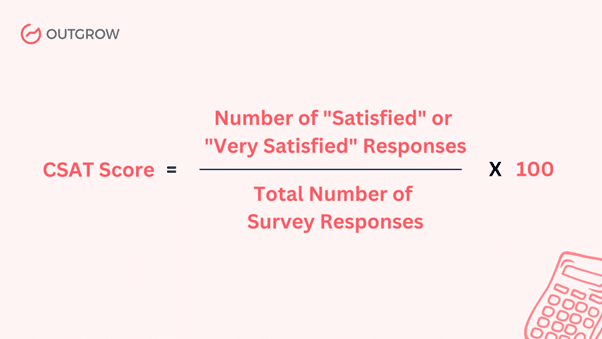
Although a score of 90% or above is considered good, it is crucial to constantly strive for improvement and aim for even higher scores.
Regularly analyzing customer feedback, identifying areas for improvement, and implementing corrective measures can help businesses enhance their customer service and support performance. You can also train your staff with the latest helpdesk tools, call center software and live chat platforms to improve the CSAT score of your organization. Ultimately, the goal is to provide exceptional customer experiences and exceed customer expectations.
c. CES
The customer effort score indicates how much effort customers put into understanding and using your products and services or resolving their queries. Customers score it on a numeric scale, and the better your score, the less effort they have to expend.
How to calculate CSAT:
The calculation involves presenting a survey to customers and asking a simple question – “How easy was it for you to use our services?”. We usually ask this question on a 5 or 7-pointer scale, including relevant phrases like “extremely difficult” or “extremely easy”. Lower numbers indicate easy/low effort, while higher numbers suggest more effort.

Although there is no universally defined threshold for a “good” CES score, businesses generally strive to achieve a CES score lower than their previous scores.
Comparing your CES score with competitors can help provide context and identify areas for improvement.
Conclusion
To develop an effective customer-centric strategy, it is crucial to gain a deep understanding of your customer base. To meet this requirement, you need to diverge from traditional marketing approaches and, instead, prioritize being attuned to their needs and preferences.
If your goal is to prioritize your customers and make them feel valued, it is essential to enhance interactivity in your brand and communication channels. By creating more interactive experiences, you can foster engagement, gather valuable feedback, and demonstrate a genuine commitment to meeting your customers’ expectations.
And, the best one-stop solution for going interactive is using tools like Outgrow!
If you want to create some interactive pieces for your website, sign up for a 7-day free trial and see your customers stick!

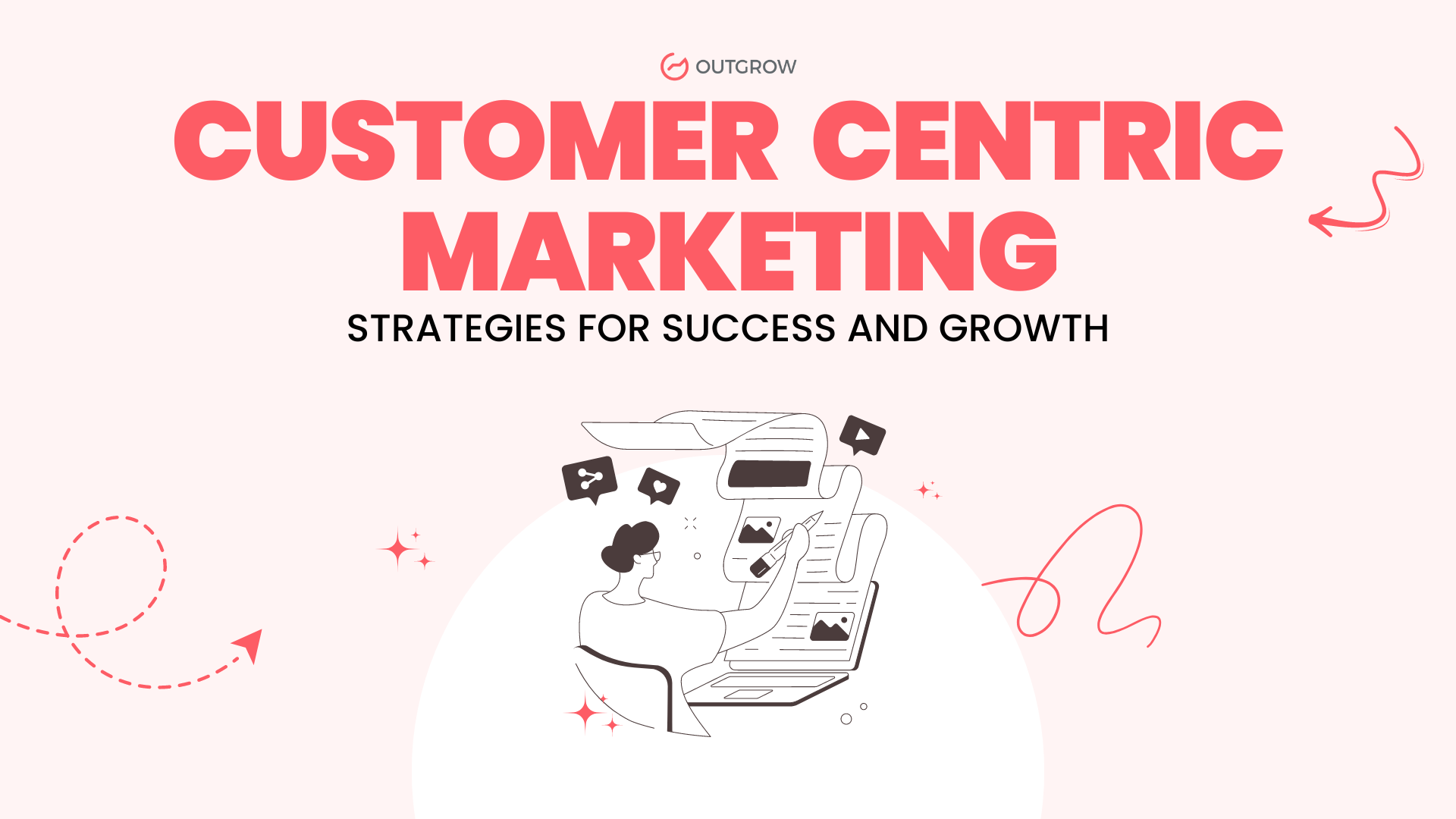


![How to Create a Branding Strategy for a Small Business? [Infographic]](https://outgrow.co/blog/wp-content/uploads/2023/05/Blogs-min-1536x768-1-1-1.png)
